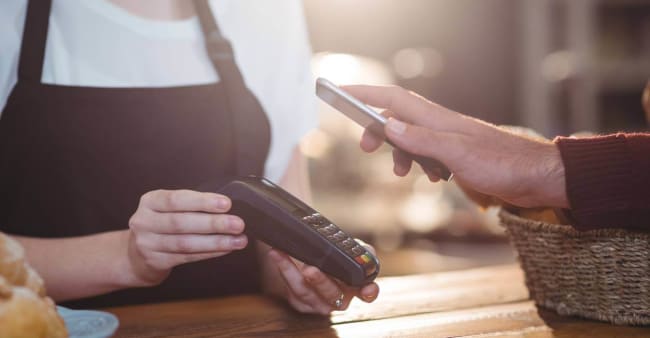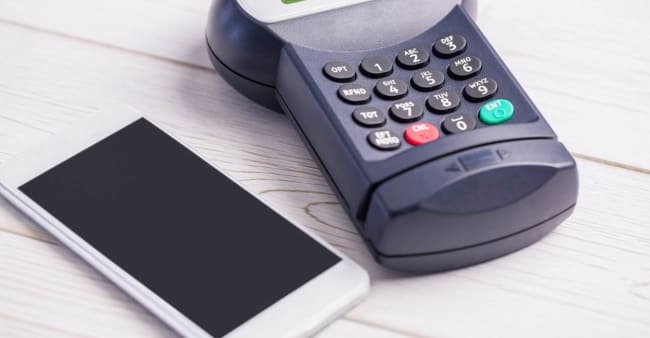A payment terminal, also known as a POS terminal, is a device that reads credit card info and processes payments. It's designed to make sales easier and speed up transactions. There are tons of payment terminal providers out there. You can find different POS models with Smile and Pay, Yavin, and also Zettle, Ingenico, Square, etc.
The transaction is recorded instantly and sent to the customer's bank by the POS terminal via a connection. This is known as remote data capture.
The POS is connected to the bank for payment authorization requests through three channels: internet connection (wired or Wi-Fi), 3G/GPRS, and telephone line. The latter option is used when the internet is inaccessible. The choice of your payment terminal can be made during the creation of your company for proper programming of your accounting management.
Some POS systems have additional features. Depending on the device you use for taking payments, you can benefit from other services such as accepting international payment methods. Other types of POS systems allow you to offer credit payments or a loyalty program. Online payment terminals also mean more convenience for retailers. Square Reader and Smile and Pay, Ingenico are leaders in the field of POS systems.
What are the different types of payment terminals?
Before buying your payment terminal, it's important to know the different types of POS terminals based on their specific features.
The fixed payment terminal
The fixed payment terminal is placed directly on a counter, usually near the cash register. This type of POS requires a subscription to an IP payment gateway to secure each transaction. It is suitable for merchants who collect small amounts during their sales. Zettle and Sumup offer POS systems of this type.
The payment terminal with Pinpad is also a fixed device to which an extended keyboard is attached. This is equipped with a bank card reader for payment. It is a terminal that offers very good security to customers and merchants alike.
The mobile and standalone payment terminal
This payment terminal is a great payment tool for merchants on the move (markets, fairs, door-to-door sales). The mobile aspect of this POS comes from its connection to a smartphone. It's a payment terminal that works through a pre-installed app. The Zettle app is a perfect example. It turns your smartphone into a complete cash register.
Yavin offers you this type of POS terminal. You can also find them at Smile and Pay, Ingenico... The Sumup 3G POS terminal is a small, stand-alone reader. It is a mobile POS model manufactured by Sumup.
Mobile payment terminals are especially useful for merchants engaged in itinerant activity, allowing them to collect payments anywhere with mobile network coverage. You can use this POS 24/7 thanks to its charging cradle.
The virtual payment terminal and the vital health POS
With the virtual payment terminal, your screen becomes a bank card reader from a web interface. The virtual payment terminal provider gives you the possibility of processing a payment on the web from the same software. This makes it easy to manage a physical sale as well as an online one. Sumup is one of the best virtual payment terminal providers.
The vital health payment terminal is designed for healthcare professionals. It allows for the reading of health cards and payment by bank card.
There's a category of payment terminals with a built-in printer for printing receipts of each transaction. There are also so-called smart payment terminals. Notable examples include myPOS mobile terminals and Fintech offerings. Smile and Pay also offers the Smart Smile, a modern payment terminal.
What are the criteria for choosing the best POS terminal for your business?
The best payment terminal is one that fits your sales business. It also needs to keep your customers' data safe. Your budget for the payment terminal can also be a factor.
The payment terminal adapted to your professional sales activity
The working environment and equipment are different depending on the profession. Thus, a self-employed person can use a payment terminal that sends notes by SMS or email to customers. A restaurateur can choose a mobile payment terminal. This allows you to collect payment by credit card directly at the customers' table.
Merchants usually use contactless terminals like the Sumup solo and Zettle, where you can insert the bank card for quick payments. You can also pay via smartphone, tablet, or smartwatch... The POS terminal can let merchants directly fund their current account for reinvesting the money from these payments.
The secure payment terminal
Merchants need to make sure their customers' data isn't hacked during payments. To do this, they need to use secure equipment. During a bank payment, lots of info goes between the POS terminal and the customer's bank. Sometimes, bad actors try to hack the company's connection to grab the customer's confidential info and get into their bank account.
To protect customer data, the terminal can encrypt the information that is transmitted during credit card payments. This makes the customer's data unusable in the event of hacking.
The payment terminal adapted to your budget
Merchants need to keep their budget in mind when picking the right payment terminal. POS terminal prices vary depending on what they can do and what features they have. The cheapest payment terminal model is the Mini Smile, a competitor to the Sumup Air and Zettle Reader.
Written by our expert Editorial staff
March 23, 2023




























